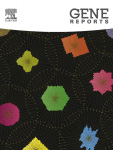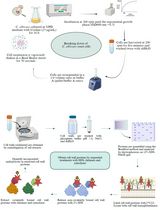- EN - English
- CN - 中文
A Yeast Chromatin-enriched Fractions Purification Approach, yChEFs, from Saccharomyces cerevisiae
酿酒酵母的染色质富集组分的纯化方法—yChEFs
发布: 2020年01月05日第10卷第1期 DOI: 10.21769/BioProtoc.3471 浏览次数: 4426
评审: Gal HaimovichMartin V KolevPia Giovannelli
Abstract
We have adapted a previous procedure and improved an approach that we named yChEFs (yeast Chromatin Enriched Fractions) for purifying chromatin fractions. This methodology allows the easy, reproducible and scalable recovery of proteins associated with chromatin. By using yChEFs, we bypass subcellular fractionation requirements involved when using zymolyase to obtain the spheroplast, which is employed in many other procedures. Employing small amount of culture cells and small volumes of solutions during the yChEFs procedure is very useful to allow many samples to be handled at the same time, and also reduces costs and efforts. The purified proteins associated with chromatin fractions obtained by yChEFs can be analyzed by Western blot (Figure 1) or combined with mass spectrometry for proteomic analyses.
Keywords: Chromatin (染色质)Background
DNA-protein macrocomplexes are usually insoluble and lost while obtaining chromatin fractions (Lambert et al., 2009). To maximize DNA-protein recovery, cellular fractionation has been used in several organisms, such as Xenopus (Liang and Stillman, 1997; Khoudoli et al., 2008), Caenorhabditis elegans (Chu et al., 2006), humans (Du et al., 2006; Foltz et al., 2006; Foltz et al., 2009), rice (Tan et al., 2007) or budding yeast (Frei and Gasser, 2000; Kubota et al., 2011). In most cases, these studies have been accompanied by proteomic analyses conducted by mass spectrometry, including quantitative mass spectrometry (Kubota et al., 2011; Lambert et al., 2012). The chromatin immunoprecipitation method (ChIP) emerged as an alternative to the above-mentioned approaches and allows interactions to be identified between protein and genomic DNA regions (Aparicio et al., 2004). However, the use of formaldehyde for in vivo crosslinking renders this method less efficient for proteomic analyses (Metz et al., 2004). ChIP combined with mass spectrometry has also been used in mouse embryonic stem cells or other model organisms (Lambert et al., 2010; Engelen et al., 2015). Notably a method based on ChIP, termed mChIP, has also been developed including protein affinity purification from chromatin that is most useful for mass spectrometry analyses (Lambert et al., 2009 and 2010).
In budding yeast, many procedures use cell fractionation by including additional steps of zymolyase treatment to lyse cell wall of viable yeast cells and then, to obtain the spheroplast before nucleus and cytoplasm separation (Liang and Stillman, 1997; Frei and Gasser, 2000; Kubota et al., 2011). Finally, a method to obtain chromatin fractions to isolate nascent RNA has been recently developed in S. cerevisiae which, without following a prior zymolyase treatment, allows chromatin fractions depleted of rRNA and tRNA to be obtained (Carrillo Oesterreich et al., 2010).
However, the need of easy and scalable procedure to obtain highly chromatin-enriched fractions in S. cerevisiae led us to adapt and improve this methodology termed yChEFs for yeast Chromatin Enriched Fractions. This procedure does away with the need to perform the cell fractionation required to obtain the spheroplast by using zymolyase incubation and to achieve nucleus isolation, which greatly facilitates the procedure and makes chromatin isolation more efficient. In addition, yChEFs allows work to be done with small solution volumes, very useful if many samples need to be manipulated. This method, allows proteins to be isolated from non-crosslinked chromatin by avoiding later sonication steps after chromatin isolation, and can be combined with mass spectrometry for proteomic analyses.
Materials and Reagents
- 50 ml centrifuge FALCON-type tubes
- 1.5 ml microtubes
- Cuvettes
- Glass beads (Retsch, catalog number: 22.222.0004)
- anti-Histone H3 (Abcam, catalog number: ab1791)
- anti-Pgk1 (Invitrogen, catalog number: 459250)
- Anti-Rabbit IgG (Sigma-Aldrich, catalog number: A0545)
- Ani-Mouse IgG (Bio-Rad, catalog number: 170-6516)
- Cell culture media:
Peptone (FORMEDIUM, catalog number: PEPCFG)
Glucose (FORMEDIUM, catalog number: GLUCFG)
Galactose (FORMEDIUM, catalog number: GALCFG)
Yeast extract (FORMEDIUM, catalog number: YEACFG)
Yeast nitrogen base (CONDA, catalog number: 1553)
Ammonium sulfate (PanReac AppliChem, catalog number: 141140)
Uracil (Sigma-Aldrich, catalog number: U-1128)
L-Methionine (FORMEDIUM, catalog number: DOC0168)
L-Tryptophan ((FORMEDIUM, catalog number: DOC0187)
Adenine sulphate (FORMEDIUM, catalog number: DOC0229)
L-Leucine (SIGMA ALDRICH, catalog number: L8912)
L-Lysine monohydrate (FORMEDIUM, catalog number: DOC0159)
L-Histidine (FORMEDIUM, catalog number: DOC0144) - MilliQ H2O
- HEPES (iNtRON BIOTECHNOLOGY, catalog number: 1017365)
- KCl (PanReac AppliChem, catalog number: 131494)
- NaCl (PanReac AppliChem catalog number: 121659)
- MgCl2 (Sigma-Aldrich, catalog number: M9272)
- CaCl2 (PanReac AppliChem catalog number: 131232)
- Triton X-100 (PanReac AppliChem, catalog number: 142314)
- Sucrose (Sigma-Aldrich, catalog number: S9378)
- Spermidine (Sigma-Aldrich, catalog number: S2626)
- Spermine (Sigma-Aldrich, catalog number: S3256)
- EDTA (PanReac AppliChem, catalog number: 131669)
- Glycerol (PanReac AppliChem, catalog number: 141339)
- IGEPAL CA-630 (NP-40) (Sigma-Aldrich, catalog number: I8896)
- Urea (Sigma-Aldrich, catalog number: U-6504)
- DTT (FORMEDIUM, catalog number: DTTCFG)
- PMSF (Sigma-Aldrich, catalog number: P7626)
- Tris (PanReac AppliChem, catalog number: 141940)
- SDS (BioPure, catalog number: 8030S)
- Bromophenol blue (Sigma-Aldrich, catalog number: B5525)
- Β-Mercaptoethanol (Sigma-Aldrich, catalog number: M3148)
- N-butyric acid (Sigma-Aldrich, catalog number: B103500)
- Buffer 1 and Buffer 2 (see Recipes)
- Sample Buffer (see Recipes)
- Cell culture media (see Recipes)
- Yeast complete medium YPD
- Synthetic dropout medium (SD)
Equipment
- 500 ml Erlenmeyer glass flasks
- Refrigerated-regulated centrifuges (for 50 ml tubes: Hettich, model: Universal 32R; for 1.5 ml tubes: Beckman Coulter, model: Allegra 21R)
- Spectrophotometer: Ultrospec 10 Cell Density Meter (Amersham Biosciences)
- Vortex (Genie 2 with TurboMix Attachment, a multisample device)
- Orbital shaker/ incubator for yeast culture: Multitron Standard (Infors AG)
Procedure
文章信息
版权信息
© 2020 The Authors; exclusive licensee Bio-protocol LLC.
如何引用
Cuevas-Bermúdez, A., Garrido-Godino, A. I., Gutiérrez-Santiago, F. and Navarro, F. (2020). A Yeast Chromatin-enriched Fractions Purification Approach, yChEFs, from Saccharomyces cerevisiae. Bio-protocol 10(1): e3471. DOI: 10.21769/BioProtoc.3471.
分类
微生物学 > 微生物细胞生物学 > 细胞器分离
微生物学 > 微生物蛋白质组学 > 全生物体
分子生物学 > 蛋白质 > 检测
您对这篇实验方法有问题吗?
在此处发布您的问题,我们将邀请本文作者来回答。同时,我们会将您的问题发布到Bio-protocol Exchange,以便寻求社区成员的帮助。
提问指南
+ 问题描述
写下详细的问题描述,包括所有有助于他人回答您问题的信息(例如实验过程、条件和相关图像等)。
Share
Bluesky
X
Copy link













